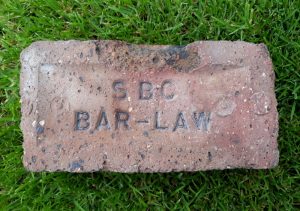Source – Whitehill Colliery was a deep mine colliery and was serviced by rail running between Dykes Junction and the colliery. By the mid-30s the mining company had improved the site by removing and reconstructing the ambulance room and constructing the pithead baths. The pit entrance was below the central tower and the baths were on the right and the locker rooms were arranged end to end with the bathhouse behind them. These were built to accommodate 462 men. The exterior of the building was finished in cream-coloured cement rendering. The restyled colliery buildings were opened on 6th July 1934 and cost £8,580.
With the nationalisation of the coal industry after the war, Whitehill was taken over by the National Coal Board in January 1947 with the NCB flag being unfurled by James Finn the oldest worker at the time. Whitehall continued operating until flooding in 1965 resulted in closure thereby ending over 200 years of mining in Cumnock Parish.
Skares Brickworks was situated to the north of the mine and was operated by the National Coal Board from 1954-1969 and then by the Scottish Brick Corporation from 1969 to 1984 and thereafter by GISCOL from 1984 – 1987. It had 1 Hoffman Kiln with 28 Chambers and produced 47,000 bricks a day with 16 men. Each brick weighed 10lbs and was fired for 10 days and emerged as 8lb bricks. Coal-fired kiln. The blaes (waste deposit of colliery spoils and spent oil shale) to supply the works come from Whitehill and Hindsward Colliery. The Brickworks and Colliery occupied 12.5 hectares of land. In the 1960s, the manufacture of bricks and excavation of coal ceased and the site was decommissioned. But it is said that Skares produced bricks up until the early ’90s when bricks still left the works as haulage contractors moved approximately 2-3 million stockpiled bricks at discounted rates.
The recycling company, Digit Site Services purchased the land from local farmers in 2000. The site consisted of three main areas: Skares brickworks, the Whitehill Colliery spoil heap or bing and former agricultural land and woodland degraded by flooding from spoil heap water run-off and after extensive environmental intervention mixed woodland and grass was planted over the entire site. The regenerated woodland and wetland is now a rich habitat for a range of plants, animals and birds.
1954 – 1969 – The 1985 publication ‘A survey of Scottish brickmarks’ suggests these works were operated by the National Coal Board during this period.
Nov 1958 – Clay Worker Magazine – Skares – Russians visited NCB works – Britains most modern works – at Skares recently. 47,000 bricks a day with 16 men. Each brick weighs 10lbs. Fired for 10 days and emerges as 8lb bricks. Coal-fired kiln. The blaes to supply the works come from Whitehill Nos 3 & 4 and from Hindsward Colliery.
1969 – 1984 – The 1985 publication ‘A survey of Scottish brickmarks’ suggests these works were operated by the Scottish Brick Corporation during this period.
1984 – closure – The 1985 publication ‘A survey of Scottish brickmarks’ suggests these works were operated by the Glasgow Iron and Steel Company Limited during this period.
Additional information – The former Skares Brickworks and Whitehill Colliery, occupying 12.5 hectares of Brownfield land, is located approximately 4 km west of Cumnock, between the A70 and the B7046, some 2 km north of the village of Skares in East Ayrshire. Digit Site Services purchased the land from local farmers in 2000. The site consisted of three main areas see Figure 1:
Area 1. The former Skares Brickworks, approximately 3 hectares, was operational from the late nineteenth century until 1962.
Area 2. A spoil heap arising from the dismantled Whitehill Colliery which closed in 1963.
Area 3. Former agricultural land and woodland degraded by flooding from spoil heap water run-off. In the 1960s, the manufacture of bricks and excavation of coal ceased and the site was decommissioned.
************************
Machinery from the Dunaskin Brickworks was removed on the closure to Skares Brickworks, Cumnock in 1977, where it lay and rusted until it was removed for scrap. – John Dinwoodie 08/06/1999…
***********************







